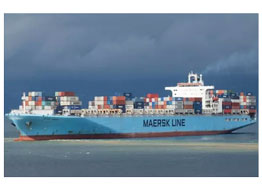Maersk still leads as biggest box carrier with Hamburg Sud buyout
Maersk still leads as biggest box carrier with Hamburg Sud buyout
DENMARK’s Maersk Line has now retained its lead in world container shipping from a challengers now that it has taken over Germany’s No 2 shipping line Hamburg Sud.
Singapore’s Business Times reports that the combined entity now holds an 18 per cent share of global capacity up from 15 per cent before the EUR3.7 billion (US$4.3 billion) acquisition.
“Our strategy is to move away from being a conglomerate to being a company focused on transportation and logistics,” said Maersk’s chief commercial officer Vincent Clerc.
“With the acquisition of Hamburg Sud, we are really cementing our leadership position in container transportation, and we are building our presence in key markets like Latin America and Oceania, where Hamburg Sud has historically been strong,” he said.
Maersk ranks as the biggest container shipping line worldwide with 646 vessels, while Hamburg Sud is the seventh largest, with 116 ships.
Maersk said it will now move to reflag most of Hamburg Sud’s vessels, including some of the German-flagged ships, to either Denmark or Singapore.
This exercise will likely be completed over the coming months, said Mr Clerc, although the company has yet to decide on the exact number of vessels that will fly each flag.
Maersk has investments in Singapore totalling over US$12 billion, including 46 vessels and rigs under the Singapore flag.
“For a long time, we’ve built very deep relationships in Singapore, we’ve had a lot of activities here – it’s a place that makes sense for us,” said Mr Clerc.
“And as we integrate Hamburg Sud and continue to grow as a company, Singapore will benefit with an increase in numbers for the transshipment moves happening here,” he added. All of Hamburg Sud’s transshipment activities for south beast Asia will remain in Singapore, unchanged.
Already, Maersk’s share of transshipment volumes through Singapore has grown significantly in recent years, even as the shipping line continues to utilise its dedicated berths at Malaysia’s Tanjung Pelepas port. Singapore handled 4.5 million TEU of Maersk boxes in 2016, up 69 per cent from the 2.7 million TEU of 2013.
“Singapore has traditionally been one of the real pivot areas for trade and shipping, and south east Asia is the area in Asia that is seeing the strongest growth right now. Obviously, Singapore is the natural transshipment hub for south east Asia,” said Mr Clerc.
That said, Maersk’s acquisition of Hamburg Sud will only have “a minor impact” on box traffic coming through Singapore since the German firm is a relatively small carrier in the South-east Asia region, said Tan Hua Joo, executive consultant of Alphaliner.






